Discovering Hanging Planters: Selection and Styling
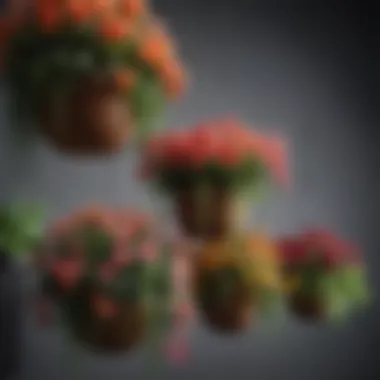
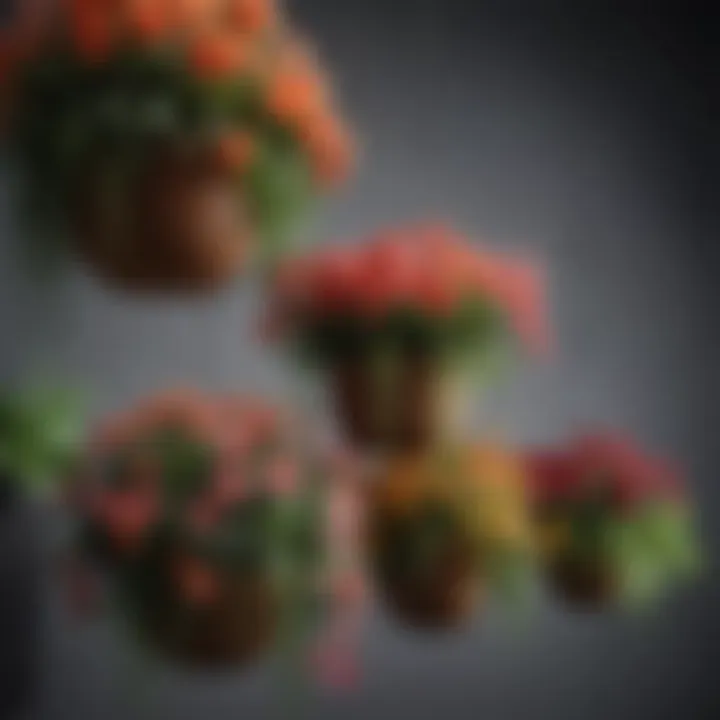
Intro
Hanging planters have grabbed the spotlight in garden design and interior aesthetics, allowing flowers and greenery to flourish in spaces that may seem too cramped for traditional gardening. They offer a delightful combination of beauty and functionality, elevating your living spaces while adding a dash of personality. Each hanging planter tells a story and contributes uniquely to the ambiance of a room or garden.
This article takes you through the many intricacies involved in selecting and styling hanging planters. From choosing the right flowers to practical care tips, we will cover it all, ensuring both novices and seasoned green thumbs find something valuable.
Design Inspiration
Current Interior Design Trends
Hanging planters have become a mainstay in many interior design concepts. Consider the minimalist approach that emphasizes open space and natural materials. A few strategically placed hanging planters can tie together a living room's aesthetic by providing pops of color against neutral backdrops. Conversely, a bohemian style embraces the charm of various textures and patterns, where eclectic hanging planters can infuse creativity and warmth.
Color Palettes and Their Effects
Colors play a crucial role in how we perceive our spaces. A vibrant hanging planter with bold hues can invigorate a calm environment, while softer, pastel tones might invite relaxation.
Some popular color schemes include:
- Monochromatic: Utilizing varying shades of a single color can create a sophisticated vibe, allowing floral arrangements to stand out without clashing.
- Complementary Colors: Pairing opposing colors on the color wheel, such as orange and blue, encourages visual interest and energy.
- Analogous Colors: Using neighboring colors, like purple and pink, produces a harmonious and serene effect.
"The right color combinations can completely transform the perception of a space, making it more inviting or energizing as needed."
Entertaining Ideas
Themed Party Concepts
Involving hanging planters can add a delightful twist to your entertaining setups. Imagine an outdoor summer barbeque decorated with hanging greenery that complements the theme. Alternatively, think about an urban garden party where sophisticated vertical planters serve as natural dividers between casual seating areas while providing ambiance.
Menu Planning and Recipes
The essence of any gathering lies within the food served. Plan a menu that celebrates fresh flavors. For instance, consider herb-infused dishes that echo the ongoing theme of nature. Dishes like:
- Herb-Infused Grilled Chicken: Using fresh aromatic herbs from your own hanging planters to marinate your proteins.
- Floral Tea Infusion: Create creative beverages using edible flowers from your hanging setup.
This connection between culinary delights and your flourishing hanging design can leave a lasting impression on your guests, making the entire event intertwined with beauty and taste.
Prelude to Hanging Planters
Hanging planters have captured the imagination of homeowners and gardening enthusiasts alike, adding life and vibrancy to spaces that might otherwise feel sparse. The allure of displaying plants at eye level or above goes beyond aesthetics; it provides a unique opportunity to optimize space and showcase floral beauty in a variety of contexts. For urban dwellers with limited square footage or even those in suburban settings with sprawling gardens, these planters serve both functional and decorative roles. They allow for creativity in design and can transform any drab corner into a lively garden display.
Historical Context
The art of hanging planters dates back centuries, tracing its roots to ancient civilizations. For instance, the Babylonians are famously known for their Hanging Gardens—one of the seven wonders of the ancient world. Though they may not have utilized modern-day planters, their pursuit of greening elevated spaces laid a foundation for today’s practices. Throughout history, various cultures have embraced the concept of elevating flowers or herbs, stretching from the basket-style planters of the Middle Ages in Europe to the intricate macramé designs of the 1970s. Each variation illustrates an evolution in both artistry and purpose.
More recently, the mid-20th century saw a surge in indoor gardening. As urbanizations increased and people began living in tighter quarters, hanging planters provided an easy way to incorporate greenery into homes without sacrificing floor space. This adaptable style has continued to evolve, reflecting changes in design trends and environmental awareness over the decades.
Modern Adaptations
Today, hanging planters have undergone a renaissance of sorts. With a wealth of materials and designs available, they cater to a growing desire for both aesthetics and sustainability. Homeowners are not just looking to incorporate plants into their spaces but are considering carefully how their choices reflect their values.
The rise of eco-conscious living has led to an increased interest in self-watering planters, vertical gardens, and designs that integrate recycled materials. Furthermore, social media platforms have not only inspired DIY enthusiasts but have also sparked a renewed appreciation for the artful placement of hanging planters in homes.
From ceramic pots with unique glazes to rustic wooden crates, the variety at one’s disposal makes it easy to find a match for any home decor style. Manufacturers are increasingly pairing technology with design, creating planters that are not just visually appealing, but also practical.
In a nutshell, the journey of hanging planters from historical symbols of beauty to modern-day sustainable art forms exemplifies the intersection of functionality and style. As we navigate through the following sections, we will explore the types of flowers suited for hanging planters, styles to consider, and more. There's a remarkable potential to enhance any space—whether it’s a shaded nook on a balcony or a sunlit kitchen window—waiting to be tapped.
Types of Flowers for Hanging Planters
Selecting the right flowers for hanging planters is like choosing the perfect accessories for an outfit—each complementing the overall look while also serving a functional purpose. The beauty of hanging planters lies not just in their arrangement but also in the variety of blooms that adorn them. Different types of flowers bring unique characteristics such as texture, color, and growth habit, all of which can transform a simple planter into a vibrant focal point.
Annuals vs. Perennials
When considering flowers for hanging planters, the first distinction that comes to mind is between annuals and perennials. Annuals, as the name implies, complete their life cycle within a single growing season. They bloom profusely and provide instant gratification with vibrant displays
- Example Annual Choices: Petunias and Geraniums stand out for their resilience and colorful blooms throughout summer.
Perennials, on the other hand, are the steadfast performers. These plants return year after year, often growing stronger and more vigorous each season. Incorporating perennials can be a shrewd move for long-term enjoyment, as they establish themselves while you tend to the other rotating annuals.
- Example Perennial Choices: Consider plant varieties like Fuchsia or Hoya, which, while delicate-looking, can flourish beautifully in a hanging arrangement
Knowing whether to choose annuals or perennials really all comes down to the gardener’s preferences and plans for their hanging garden.
Vining and Trailing Varieties
Vining and trailing flowers are like the stars of the show when it comes to hanging planters. They create dramatic cascades that can lend a sense of motion and liveliness to any space. These varieties often outshine their upright companions with their sprawling, lush foliage and vibrant blooms that seem to tumble gracefully
- Popular Vining Varieties: Sweet Potato Vine brings bold chartreuse leaves that can spill over the edges dramatically.
- Trailing Varieties Examples: Lobelia and Nasturtium add splendid bursts of color and can be quite resilient to various weather conditions.
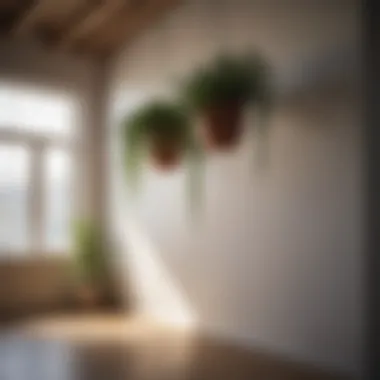
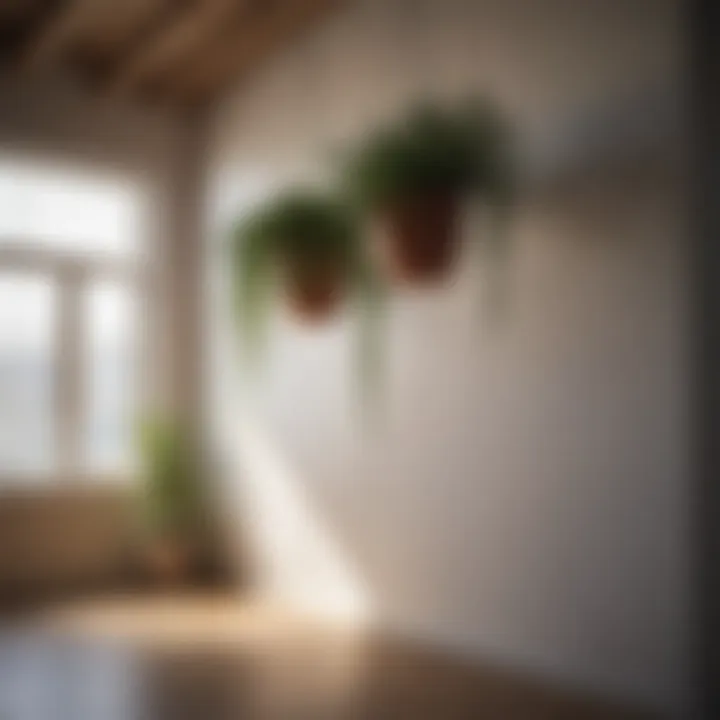
Moreover, including a mix of vining and trailing varieties can engage the eye—creating layers within your planter ensemble that demand attention from anyone passing by
Seasonal Considerations
The season plays a substantial role in the types of flowers you can choose for your hanging planters. Each season brings its own set of ideal plants. During the spring, bright and cheerful blooms like Pansies capture the spirit of renewal, while the summer months are quintessential for lush and colorful blooms. In fall, opting for more muted colors with plants like Asters or ornamental Kale adds a perfect autumnal touch.
Moreover, the climate in your region can heavily influence your choices. If your area experiences cold winters, it can be beneficial to select hardy varieties that can withstand cooler conditions or even transition to winter arrangements that showcase evergreen foliage or seasonal accessories like pinecones and ribbon.
- Quick Tips for Seasonal Planting:
- Monitor your local climate to choose the best flowering options.
- Group flowers with similar watering and sunlight needs together for better maintenance.
"Matching your plant types with seasonal conditions opens up endless possibilities for creativity in your hanging planters."
Choosing the Right Planter Style
Choosing the right planter style is more than a simple decorative decision. It holds the key to the health and aesthetics of your plants. Different styles not only enhance the beauty of your space but also affect your plants’ growth depending on their materials and design. When you're selecting hanging planters, think about how style and structure can elevate your indoor or outdoor space while ensuring practicality in upkeep. The right planter can add character to any setting while providing a cozy home for your beloved flora.
Material Choices
The material of your hanging planters plays a crucial role in their durability and effectiveness in plant care. Three predominant materials often come into play are wood, metal, and ceramic. Each brings something unique to the table.
Wood
Wooden planters are often favored for their natural look. They blend effortlessly into many environments, whether garden or balcony. The key characteristic of wood is its organic appeal. It can be stained or painted to match your theme, adding a warm touch. A distinct feature here is its insulation; wooden planters keep roots cooler in summer, promoting healthier plants. However, wood is susceptible to decay and requires proper treatment. Choosing pressure-treated wood or naturally rot-resistant types like cedar can help in longevity. The trade-off, nonetheless, is worth considering, as the aesthetics wood offers are hard to beat.
Metal
Metal planters are known for their sleek and modern finish. They come in various finishes, providing a contemporary edge to your décor. The robustness of metal gives it an advantage because it is less prone to wear and can withstand outdoor elements better than wood. Durability is a highlight here, as metal can last for years if properly cared for. One unique feature is its varied textures; a shiny aluminum or rusty iron can create different moods in a space. However, be wary of heat retention, as metal can heat up in the sun, which may affect the roots of your plants.
Ceramic
Ceramic planters are perhaps the most diverse in terms of design, available in an array of colors and styles. The highlight of ceramic is its ability to maintain moisture, which is beneficial for plant roots. They are often glazed, providing an added layer of beauty and a non-porous surface, which helps in preventing rot. A unique feature is the intricate designs that can become a focal point in your home. On the downside, ceramic can be fragile, so accidental bumps may lead to chips or cracks. Their weight also means they are less suited for hanging in high places unless securely fastened.
Design Aesthetics
When it comes to design aesthetics, the style of a hanging planter can transform the feel of a space. Three common styles stand out: contemporary, traditional, and rustic.
Contemporary
Contemporary planters are all about clean lines and minimalism. Their key characteristic is simplicity, allowing the plants to take center stage without overwhelming the surroundings. These planters usually employ modern materials like metal and synthetic composites. A notable advantage is their versatility; they can fit well in both indoor and outdoor settings, making them a smart choice for various design schemes. But sometimes, the sleekness may not resonate with those who prefer a bit more charm in their design.
Traditional
Traditional planters often feature intricate designs and ornate details, which lends a classic feel. The key aspect here is the craftsmanship, as many traditional styles are handmade. If you're after a homely vibe, these are a beneficial choice as they exude warmth and nostalgia. They can complement classic architecture beautifully. The downside, however, is that they might not fit well in modern settings without careful consideration.
Rustic
Rustic planters embrace natural imperfections, bringing a touch of earthiness to your décor. With the key feature being their raw materials like distressed wood or wrought iron, they are perfect for those who yearn for an unrefined but cozy atmosphere. Their charm lies in their versatility; they can work well in a countryside home or a bohemian-style apartment. A consideration here is that rustic items may not have the durability that some homeowners seek, but for many, their character is worth the trade-off.
Ultimately, the best choice often combines personal preference with practical considerations, striking a balance between aesthetics and functionality.
In summary, selecting the right planter style will enhance not only the beauty of your plants but also improve their health and longevity. Each material and design has its strengths and weaknesses, but this variety allows you to curate an environment that speaks to your personal style while nurturing your greenery.
Practical Aspects of Hanging Planters
Understanding the practical aspects of hanging planters is crucial in ensuring they are both functional and aesthetically pleasing. It's not just about the visuals; care considerations can make or break the success of your vertical garden. From assessing weight to mastering watering techniques and ensuring soil health, each element plays a vital role in the longevity and vibrancy of your plants. This section delves into essential factors that can help any gardener, whether seasoned or just starting out, make the most of their hanging planters.
Weight Considerations
When it comes to hanging planters, weight is a critical factor. Overloading your hooks and chains can lead to unfortunate accidents. Think about it this way: how many times have you seen a plant tumble to the ground, pot and all? That’s primarily from not considering the weight of the planter, soil, and water combined.
- Choose sturdy materials: Materials like wrought iron or heavy-duty plastic are generally more supportive of heavier loads.
- Use proper hooks: Ensure the hooks you select can handle at least double the weight of your planter and its contents. A flimsy hook can be the weak link in your setup.
- Consider the hanging method: Macramé hangers are trendy, but check that they distribute weight evenly rather than concentrating it on a single point.
- Plan for water retention: Remember, because plants need watering, the weight of your planters will increase significantly when they are moist. This is where calculations come in handy.
Watering Techniques
Getting your watering process down is like finding a rhythm in a dance; it's about balance. Too much watering can drown your plants, while too little turns them into sad, withered versions of themselves.
- Water thoroughly but infrequently: Design a schedule that promotes thorough soaking but allows the soil to dry slightly between waterings. This encourages root growth and prevents rot.
- Check drainage holes: Always ensure your planters have drainage holes. A well-drained pot can save plants from the dreaded botrytis blight—an ugly fate for any flower.
- Consider using self-watering systems: For those who might get sidetracked, self-watering planters can be a lifesaver. They keep the soil consistently moist without the risk of overwatering.
- Be mindful of rain: If your hanging planters are outside, consider how rain affects them. Excessive rainfall can lead you to rethink your watering routine.
Soil and Drainage Needs
The right soil mix is equally as important as the plants themselves. Just like a chef needs quality ingredients to make a great dish, plants require a quality soil mix to thrive.
- Opt for lightweight mixes: For hanging planters, using a lightweight potting mix can help reduce weight and improve drainage. Look for mixes that include vermiculite or perlite.
- Understand plant needs: Some plants require specific soil conditions; for example, succulents thrive in sandy soils while ferns prefer moisture-retaining mixes. Make it a point to match your soil choice with your plant’s needs.
- Draining layers are key: If you want to ensure a well-drained environment, add a layer of gravel or ceramic chips at the bottom. This will help excess water filter away from the roots.
- Regularly refresh the soil: Over time, nutrients deplete. Make it a habit to refresh your soil mix or add fertilizers periodically to keep your plants healthy and happy.
"The art of gardening is as much about the soil as it is about the blooms. Never underestimate the power of a good potting mix."
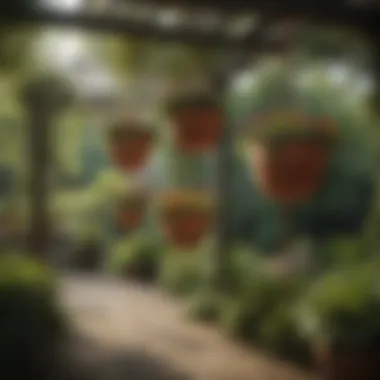
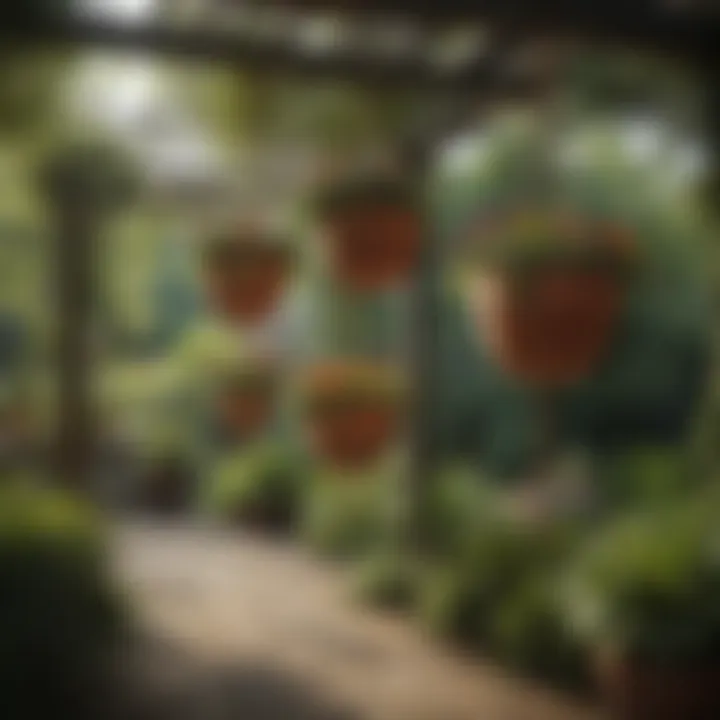
Understanding these practical aspects not only enhances the health and appearance of your plants but also offers peace of mind as you curate your hanging garden. With careful attention to weight, watering, and soil, you are well on your way to creating a thriving hanging planter display.
Planting and Maintenance Tips
The beauty of hanging planters goes beyond their visual appeal; it relies heavily on proper planting and consistent maintenance. Understanding these elements not only elevates the overall aesthetics but also ensures that your plants thrive. Poor planting techniques or careless maintenance can lead to wilting leaves or unsightly drooping, defeating the purpose of having such eye-catching displays. Therefore, the goal here is to provide essential tips that facilitate a flourishing hanging garden.
Potting Techniques
The art of potting plants into hanging planters is where it all begins. A solid potting method can mean the difference between a vibrant display and a lifeless one. Start with choosing the right potting mix—look for a well-draining mix that retains sufficient moisture while allowing excess water to escape. This is crucial because hanging planters often have limited space for roots, making swift drainage vital.
When transferring plants into hanging containers, make sure to gently loosen the root ball. This encourages roots to spread out, establishing a healthy foundation. Layering is also an essential technique; placing a small amount of potting mix at the bottom, then adding the plant, followed by more mix to secure it, is a foolproof way to avoid compacted roots.
Quick Tips for Potting:
- Choose the Right Size Planter: Ensure it’s not too big or too small for the plant.
- Layering for Drainage: Consider using pebbles at the bottom for extra drainage.
- Water Before Potting: Moisture helps with easier handling of the plants.
Common Pests and Diseases
Gardening can sometimes feel like a battle against nature, especially when pests and diseases decide to make themselves at home in your plants. Fortunately, with proper monitoring and action, this can often be managed effectively.
Regularly inspect your hanging planters for common culprits such as aphids, spider mites, or whiteflies. These pests can suck the life out of your plants, but early detection is your best defense. You can use insecticidal soap or neem oil as a natural remedy.
Maintaining good air circulation around your planters is another preventive measure against diseases like powdery mildew or root rot. Plants can often suffocate if they are too crowded, and this can lead to various health issues.
"An ounce of prevention is worth a pound of cure." Always take your time to monitor your plants closely.
Fertilization Practices
Like humans, plants also require nourishment to grow strong and healthy. Fertilizing hanging planters is essential to replenish nutrients that may have been depleted from the soil. However, not all fertilizers are created equal, and knowing when and how to fertilize is crucial.
Opt for a balanced, water-soluble fertilizer during the growing season—typically spring and summer. This should be mixed with water as per package instructions. Weak solutions are better; it’s better to under-fertilize than to risk burning your plants. For many varieties, fertilizing every four to six weeks is a good rule of thumb.
Key Points on Fertilization:
- Liquid Fertilizer is Ideal: It allows for quicker absorption.
- Avoid Over-Fertilizing: More isn’t better.
- Tailor to Plant Needs: Different plants have varying nutrient requirements.
In sum, nurturing your hanging planters through keen potting techniques, vigilant pest management, and appropriate fertilization can make all the difference. Embracing these practices not only enhances the aesthetics of your space but fosters a vibrant indoor and outdoor environment.
Environmental Impact and Benefits
Hanging planters aren't just a pretty face in the garden; they wield considerable influence on the environment. As we dive into this section, it is crucial to recognize how these vertical gardens can transform our urban landscapes, enhance biodiversity, and improve air quality. The role of hanging planters extends beyond mere aesthetics. They create pockets of greenery in concrete jungles, benefiting not only individual homeowners but also the broader community. Each hanging planter can act as an oasis contributing positively to both physical and emotional well-being.
Urban Gardening Benefits
Urban gardening, particularly through hanging planters, rejuvenates tired city scapes. With cities expanding at a breakneck pace, green spaces are often sacrificed. However, hanging planters can turn balconies and small patios into lush retreats. Using them, residents can:
- Create
- Tackle the issue of limited space. Even a small apartment can benefit, maximizing vertical real estate to introduce diverse plant species.
- Foster community engagement. Many urban dwellers are joining forces, creating communal hanging garden projects that not only beautify but also connect neighbors.
- Vibrant displays with flowers, or
- Fresh herbs immediately accessible for culinary needs
Through these initiatives, communities often share tips, experiences, and even produce, leading to a more sustainable urban lifestyle.
Air Quality Improvement
Pollution is a bitter pill to swallow, especially in urban settings where air quality can take a nosedive. Hanging planters, though, can serve as green lungs for cities. Plants within these planters absorb carbon dioxide while pumping out fresh oxygen. Moreover, they trap dust and particulate matter, offering respite from the grime that often coats our vibrant city life.
Research supports that integrating more greenery can significantly reduce local temperatures and mitigate the urban heat island effect. Here are some benefits to consider:
- Absorption of pollutants: Common indoor plants like spider plants and pothos thrive in hanging containers and are known to purify the air by removing harmful chemicals.
- Sound insulation: The presence of plants can dampen sound pollution, creating a quieter environment.
- Psychological benefits: Beyond the science, having greenery around can boost mood and enhance productivity.
By incorporating hanging planters into the urban landscape, we can carve out niches that not only encourage plant growth but also foster healthier and happier living environments.
In summary, the environmental impact of hanging planters is significant. From fostering urban gardening initiatives that encourage community involvement to improving air quality and absorbing pollutants, these planters are more than decorative elements; they are vital players in promoting sustainability and enhancing quality of life.
Incorporating Hanging Planters in Interior Design
Incorporating hanging planters into interior design is not just about aesthetics; it elevates the ambiance and enhances the functionality of living spaces. These versatile planters bring a splash of color and texture while promoting an environment that feels fresh and vibrant. In a world where urbanization often leads to a disconnect from nature, hanging planters serve as a bridge that reconnects interiors with the great outdoors.
Living Spaces
Integrating hanging planters in living areas can drastically transform a room's vibe. Whether it’s a cozy nook or a wide-open space, these planters add visual interest and create layers that draw the eye.
- Vertical Space Utilization: In homes with limited square footage, utilizing vertical space becomes crucial. Hanging planters allow homeowners to maximize the area available, ensuring that every inch is thoughtfully designed. This kind of planning doesn't just make a space look bigger; it also creates an illusion that draws your gaze upward.
- Personal Touch: A well-placed hanging planter can be a conversation starter. Consider a cascading pathos or a vibrant fuchsia blooming high above the couch. These choices not only add flair but also convey the owner's personality and style, showcasing a love for nature and design.
- Mood Enhancement: Plants are natural mood boosters. Incorporating vibrant flowers and lush greens into a living space can create a sense of calm. Research has shown that greenery can reduce stress levels and promote a sense of tranquility, making it an excellent design choice for relaxation areas. Additionally, certain varieties, like lavender or jasmine, can infuse the air with calming scents and help improve overall well-being.
Office Environments
The role of hanging planters in office settings is often underestimated, yet they can profoundly impact productivity and creativity. Bringing nature into the workspace can result in a healthier environment for both employees and clients.
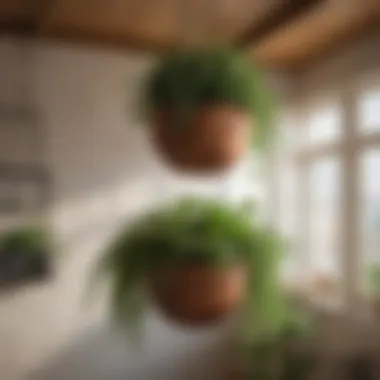
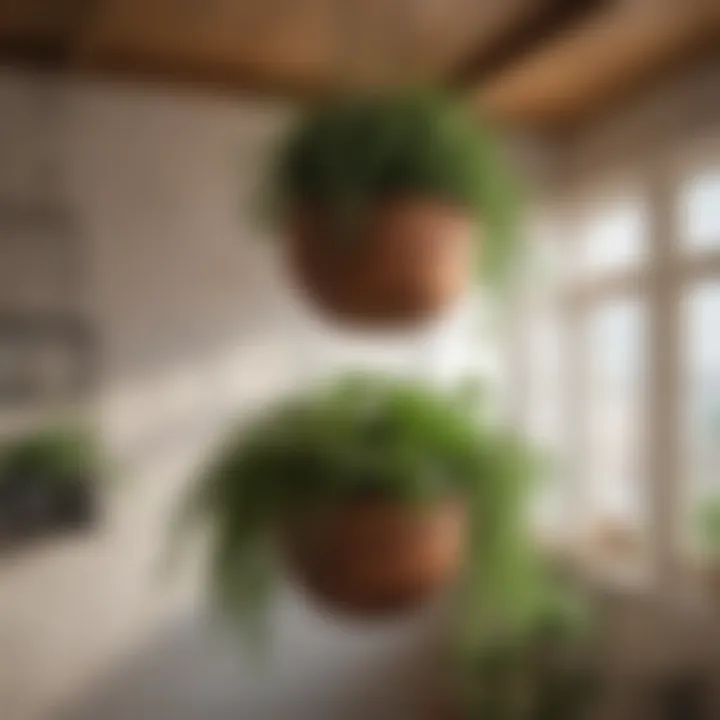
- Boosting Focus and Creativity: Various studies indicate that plants can enhance concentration levels and creativity. Strategically hanging planters near workstations provides a refreshing break from screens. The sight of lush greens and bursts of color can help reduce eye strain and promote a sense of balance.
- Creating a Welcoming Atmosphere: A workplace that incorporates greenery, especially through hanging planters, tends to feel more inviting. Clients and visitors are more likely to feel relaxed and at ease when surrounded by foliage, which is ultimately beneficial for client relations. A space that feels warm and welcoming can set the stage for deeper connections and more fruitful collaborations.
- Air Quality Improvement: Plants like spider plants and peace lilies are known for their air-purifying qualities. Hanging them in offices not only beautifies the space but ensures cleaner, breathable air for everyone in the room. The simple act of introducing plants into the office can lead to lower absenteeism and increase overall employee satisfaction.
"Introducing plants into our interiors isn’t just about decor. It’s about enriching our daily experiences and fostering connections that inspire creativity and well-being.”
Hanging Planters for Outdoor Spaces
Hanging planters hold a unique place in the tapestry of outdoor spaces, nourishing both aesthetics and functionality. They offer an ingenious solution for those looking to maximize greenery without sacrificing precious ground space. This versatility allows for creativity while maintaining room for other elements, be it furniture or pathways.
With urban living on the rise and outdoor space often at a premium, hanging planters beckon as an ideal solution. Not only do they beautify patios, balconies, and garden pathways, but they also work wonders in terms of ventilation and sunlight exposure for plants. When properly installed, they can bring life to vertical areas, which may otherwise go unnoticed.
Another upside of using hanging planters is that they often keep plants safer from pests and animals. Elevated plants can evade curious wildlife and household pets, ensuring that your flowers and herbs may thrive without disruption. In addition, they help in regulating water drainage better than traditional pots since gravity plays a helping hand in keeping the roots from becoming waterlogged.
Patios and Balconies
Creating a lush ambiance on patios or balconies becomes an art form with the incorporation of hanging planters. These spaces serve as extensions of our homes, inviting us to enjoy the outdoors while still being in a comfortable setting. Hanging planters can transform a mundane balcony railing into a riot of colors and fragrances, offering a cozy hideaway for morning coffee or evening gatherings.
When selecting planters for such areas, it’s crucial to consider both style and practicality. Opting for lightweight materials like plastic or fabric helps if the structure is not built for heavy loads. Nestled amongst other decorative elements—perhaps a couple of comfortable chairs or a small table—these planters can be a radiant focal point.
Furthermore, think about plant selection. You want a combination that not only complements color schemes but also thrives in the amount of sunlight available in your particular patio or balcony.
- Direct Sunlight: Consider succulents, petunias, or trailing geraniums.
- Partial Shade: Ferns or ivy can adapt well without direct sunlight.
Key Tip: For balconies that see strong winds, secure hanging planters well. Establishing reliable anchorage will save both your plants and your peace of mind.
"Lasting beauty comes from a balance of style, practicality, and a touch of nature."
Garden Pathways
Garden pathways offer another prime location for showcasing the beauty of hanging planters. They can lead visitors through a botanical wonderland, and as they dangle from trees or trellises, these planters can uninterruptedly introduce unique floral arrangements.
Placing hanging planters along garden pathways serves multiple functions. Not only do they guide the eye, but they also create a sense of flow, inviting wanderers to experience nature fully. They can soften hard edges of pathways and provide depth, aligning with natural elements around.
When selecting where to position the planters, consider the height. Height makes a considerable difference in how they are perceived:
- Low Hanging: Perfect for creating intimate spaces, like cozy corners with benches.
- High Hanging: Draws attention upwards, inviting exploration beyond the immediate surroundings.
Moreover, varying your plant choices along these pathways can create visual interest. A mix of brightly colored annuals and sturdy perennials can keep the garden lively across seasons. Plus, why not incorporate herbs for their aroma? Imagine the delight of passing by hanging marigolds, chives, and trailing lobelia while taking a stroll!
In summary, whether on a patio, balcony, or gracing a garden pathway, hanging planters invite creativity to outdoor spaces. They can be both showcases of natural beauty and practical additions, enhancing the enjoyment of any garden setup.
Styling Tips for Hanging Planters
When it comes to hanging planters, styling is where the real magic happens. It’s not just about choosing a planter and filling it with flowers; it's about creating a cohesive look that enhances your space. Good styling can transform a simple hanging planter into a focal point, bringing life and character to any environment. A well-styled hanging planter is a blend of color, texture, and arrangement that tie together the elements in your home or garden.
Benefits of Styling
Beyond aesthetics, effective styling can impact the health of your plants. Arranging plants with an awareness of their light and water needs helps ensure they thrive. Moreover, a thoughtful arrangement can utilize vertical space beautifully, making smaller areas appear larger and more welcoming.
Color Palettes
Color choices can make or break the overall appearance of your hanging planters. Opting for a color palette that complements your existing decor or the natural surroundings is essential. Here are some aspects to consider:
- Complementary Colors: Choose hues that contrast yet complement each other well. For example, vibrant red flowers against greenery can create a striking visual.
- Monochromatic Schemes: Sticking to one color theme, with varying shades, can create a sophisticated and harmonious look. Think about different shades of purple with lush greens in between.
- Seasonal Colors: Align your palette with the seasons. Warm oranges and yellows might reflect summer, while cool blues and whites evoke winter.
- Patterns and Textures: Mixing different textures can add depth. Soft, trailing plants paired with more structured, upright flowers often create an interesting contrast.
"Colors can adjust your environment's mood and character; they speak volumes before you say a single word."
Thematic Arrangements
Creating thematic arrangements in hanging planters can extend the storytelling aspect of your gardening. This technique can also tie in with your home's interior decorating needs.
- Cottage Garden Theme: Go for a mix of trailing daisies, petunias, and herb plants for a romantic cottage feel. This style embraces a wild and free vibe.
- Tropical Vibe: Use exotic plants like ferns, orchids, and bromeliads, set in bright, vibrant planters to evoke a lush tropical retreat.
- Minimalist Aesthetic: Select a few plants with a clean and sleek appearance, such as succulents or cacti, and use simple, modern planters. This look is all about less is more.
- Seasonal Themes: Consider changing up your plants with the seasons to maintain a fresh look. Use pumpkins and fall flowers for autumn or bright blooms during springtime.
Styling hanging planters goes beyond mere decoration; it's about creating an atmosphere. With careful consideration of color palettes and thematic arrangements, anyone can elevate their space to reflect their unique taste and personality.
End and Future Trends
As we bring our exploration of hanging planters to a close, it's essential to reflect on the importance of sustainability practices and technological innovations in this ever-evolving realm of gardening. These aspects not only influence the health and vitality of your blooms but also contribute significantly to the broader narrative of environmental stewardship and advancement.
Sustainability Practices
Integrating sustainability into the use of hanging planters has never been more relevant. Homeowners and gardening enthusiasts are increasingly looking to adopt eco-friendly practices. Choosing native plants for hanging planters can be a game changer. These plants are typically more resilient and require less water, making them a better fit for both local climates and responsible gardening.
Additionally, opting for biodegradable or recycled materials for planters minimizes the use of plastics that saturate landfills. Some folks are even getting creative with upcycling—think old teacups or wooden crates turned into charming planters. Each choice reflects a growing awareness that gardening doesn’t have to come at the expense of the environment. Plant rotation and companion planting not only promote plant health but also enhance biodiversity within gardens.
"Sustainable gardening not only beautifies your home but nurtures the whole planet, one planter at a time."
Educating oneself about chemical usage is another part of sustainable practices. Choosing organic fertilizers and pest control methods fosters a chemical-free environment for the plants and any wildlife that may interact with them. The synergy between gardening and sustainability is a relationship that can’t be overstated.
Technological Innovations
When we look toward the future, the influence of technology in the realm of gardening continues to expand. Innovations in irrigation systems—especially smart watering technologies—allow for more precise water usage, which is crucial given current concerns over water scarcity. For instance, several drip irrigation systems now come equipped with sensors that gauge soil moisture and weather conditions. This means less water waste, and ensuring your plants get just the right amount of hydration.
Moreover, apps tailored for gardening provide valuable insights like growth tracking and plant care reminders right at your fingertips. Some of these applications even utilize augmented reality, helping gardeners visualize how plants will look in their homes before making a purchase.
As communities become increasingly urbanized, vertical gardening technologies have emerged as a promising solution. Wall-mounted planters and modular garden systems are gaining popularity as they maximize small spaces while still allowing greenery to flourish. These advancements not only make gardening accessible to city dwellers but also declutter living environments, merging form with function in a stylish manner.















